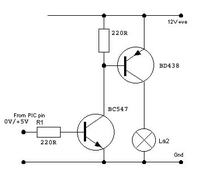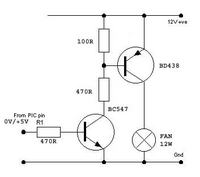JohnJohn20
Advanced Member level 4

Hi. I am using a pic to switch the +12V line to a 12 watt fan (I want to switch the +12V line rather than the 0V because I want the 0V line to always be connected to the fan so I can monitor the tacho).

Originally I had a 4k7R across the emitter and base of the BD438, but it didn't turn off properly. Even with the 220R, there is still about 0.4V across the fan.
Could this circuit be modified to get a 100% on/off?
Could I use a MOSFET to do this? What would be an example of one that could replace the BD438?
Thanks.

Originally I had a 4k7R across the emitter and base of the BD438, but it didn't turn off properly. Even with the 220R, there is still about 0.4V across the fan.
Could this circuit be modified to get a 100% on/off?
Could I use a MOSFET to do this? What would be an example of one that could replace the BD438?
Thanks.


